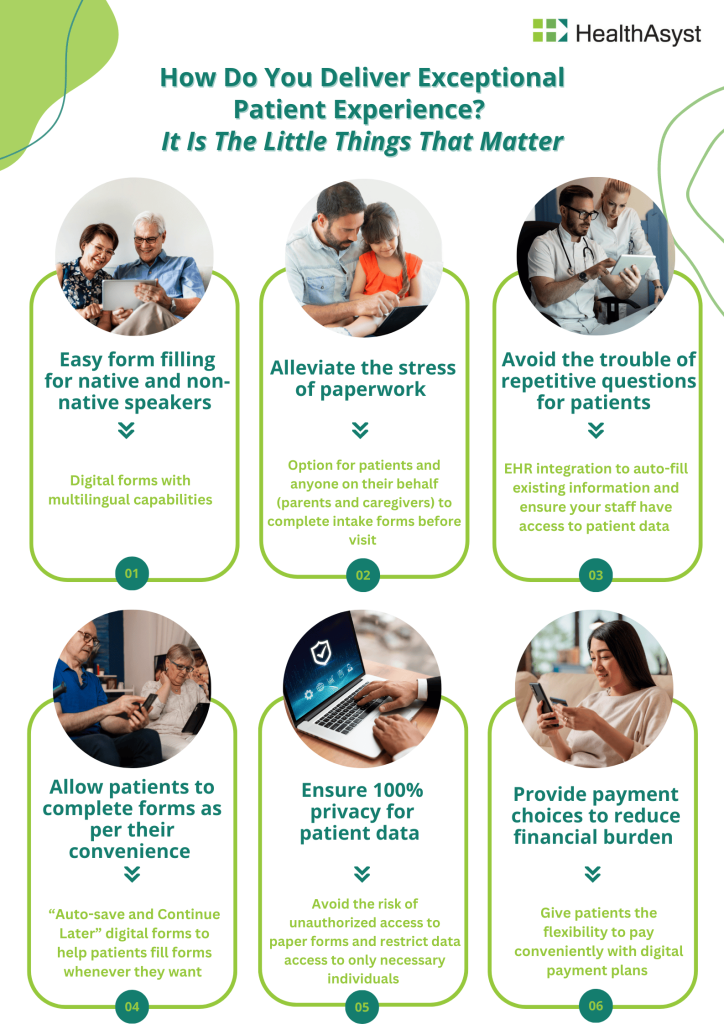Beyond the Basics: 6 Digital Intake Strategies to Go the Extra Mile in Patient Experience
In a world of digital clutter, it is very easy to become another “me-too”. That’s when the little things count.
US healthcare is gearing toward a consumer-centric approach. Providing a digital experience is no longer a differentiator, but rather a necessity to thrive among the rising competition. But how can your digital solution for healthcare practice stand out from the fluff?
Here are 6 digital intake strategies you can adopt to go the extra mile in delivering a distinctive, personalized patient experience.
How digital intake can improve the patient experience

1. Easy form-filling for native and non-native speakers
Digital solution: Digital forms with multilingual capabilities
Healthcare practices see a diverse patient population where some are non-native speakers. In such cases, filling out forms in English may seem overwhelming for most. Traditionally, clinics hire in-house or third-party medical interpreters to smoothen the experience. However, this means an additional staff doing manual, repetitive work.
Here’s where digital forms can make a positive impact for non-English-speaking patients. Multilingual digital forms allow patients to view and answer questions in their preferred language. For example, if a Spanish-speaking patient visits your practice, they can set their language preference to Spanish for reviewing and providing information accurately. This establishes a sense of inclusivity and elevates patient satisfaction beyond mere convenience.
2. Alleviate the stress of paperwork in the waiting room
Digital solution: Option to complete intake forms before the visit
Being drowned in paperwork in a chaotic front office is every patient’s nightmare. In such situations, the chances of inaccurate and incomplete information are high. The repercussions of wrong data can be devastating – both financially and in terms of care quality.
A digital intake solution can take away the “pressure cooker wait room” situation by allowing patients to complete their intake process before their appointment day. Be it their home or any comfortable setting, patients can review and enter details at their own pace. Such convenience will be a relief for patients and anyone accompanying them. For instance, a patient with a hand injury, caregivers, or parents can complete the forms comfortably from home. Once they arrive at the clinic, they can directly meet the provider.
What’s more, pre-visit registration can reduce wait times, enhance patient experience, and improve data accuracy.
3. Avoid the trouble of repetitive questions for patients at different touchpoints
Digital solution: EHR integration to auto-fill existing information
Most of us understand the frustration of providing the same information for every doctor’s visit. To tackle this, your forms should be more than just digital. Combining a digital form with a robust EHR integration helps identify existing information. So, if a patient checks-in, the intelligent forms will auto-fill already-available information. They can enter only new information and make necessary updates to the existing data. With this, patients can breeze through their intake forms and have a stress-free experience.
4. Allow patients to complete forms at their convenience
Digital solution: “Auto-save and Continue Later” digital forms
Some visits have many forms. Expecting patients to provide all the information in one go can be overburdening. Allow patients to fill out a form, pause, and resume filling at any time using intelligent forms. This can be an additional layer of convenience you can offer your patients. Also, by taking time to provide information, patients are more likely to share accurate health data.
5. Ensure 100% privacy for patient data
Digital solution: HIPAA-compliant solution with data restrictions
One of the most common HIPAA violations have been snooping, loose paper forms, and lost data.
With zero paperwork, a digital solution eliminates the common security risks of paper forms. Most digital solutions for healthcare practices are HIPAA-compliant with high-security standards to protect patient data. Practices can also ensure that only authorized people can access patient data. For instance, there are cases where caregivers or guardians accompanying the patient shouldn’t be privy to entire patient information. In such situations, practices can restrict specific questions during the intake process and avoid the risk of unauthorized access.
Read the success story of a pediatric practice who minimized HIPAA violations by restricting patient data to anyone who accompanied the patient apart from their parents.
6. Provide payment choices to reduce the financial burden
Digital solution: Flexibility to pay conveniently with payment plans
Patient responsibility continues to be a large part of bad debts. While there are multiple reasons for patients to avoid payment, higher out-of-pocket certainly adds to the pressure.
Use digital tools to ease the patient’s financial burden. Payment plans are an effective way to offer convenience and lower bad debts. Like a credit card installment, patients can choose their preferred amount or duration and enroll in a payment plan. With a steady collection, your practice can minimize large outstanding balances.
Are you looking forward to implementing a platform for your practice with these digital intake strategies? Or is your existing solution capable of providing the above functionalities? Learn how CheckinAsyst can help.







